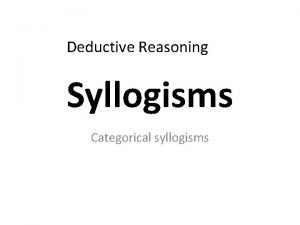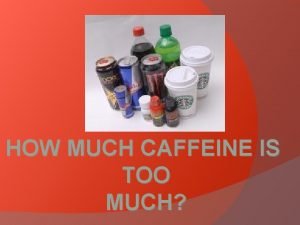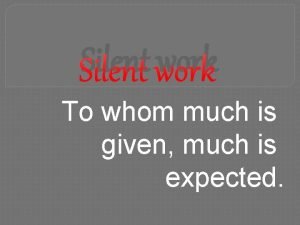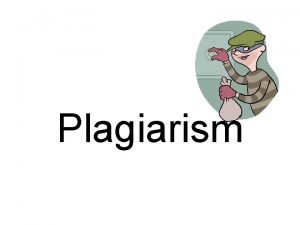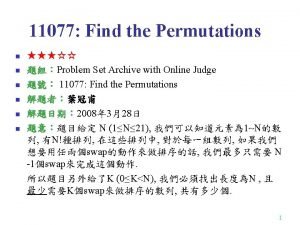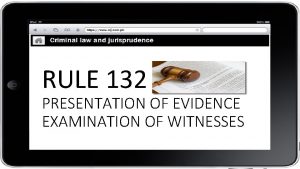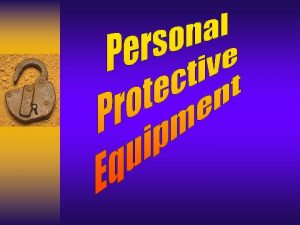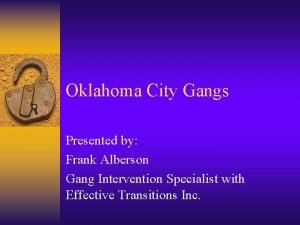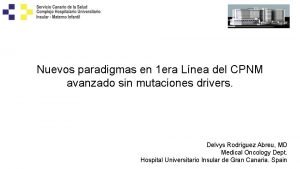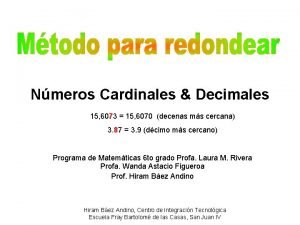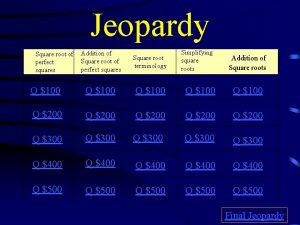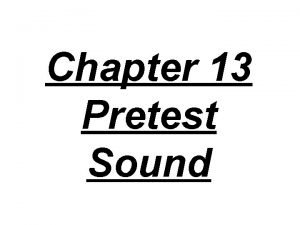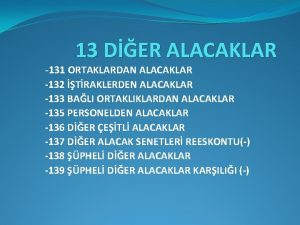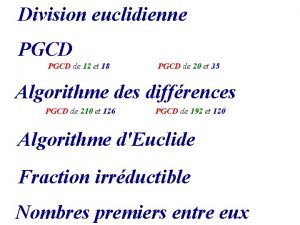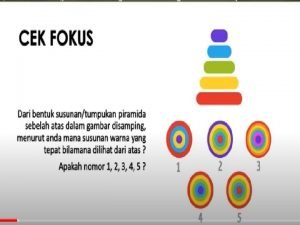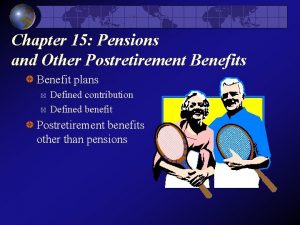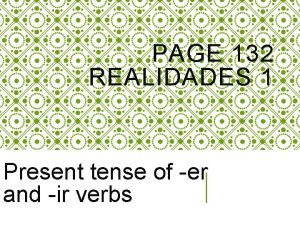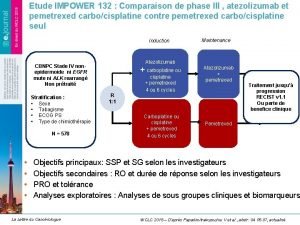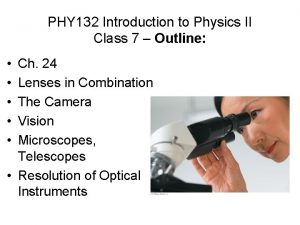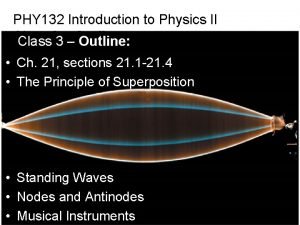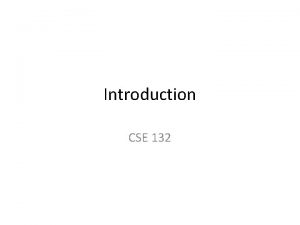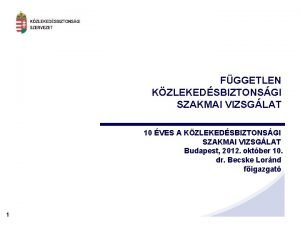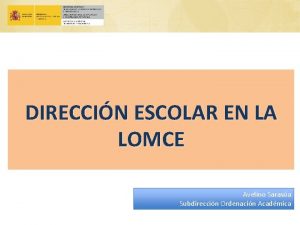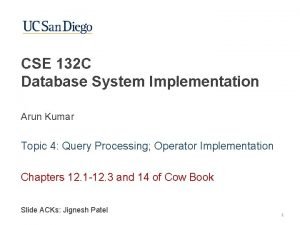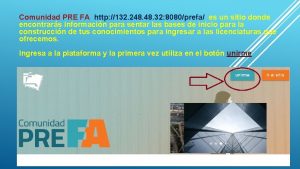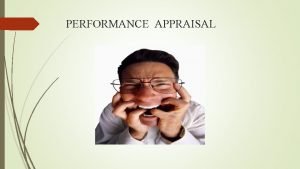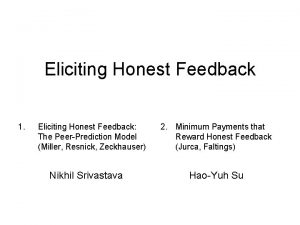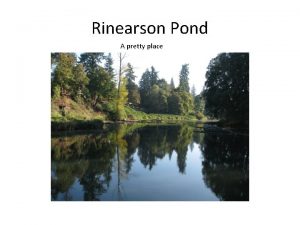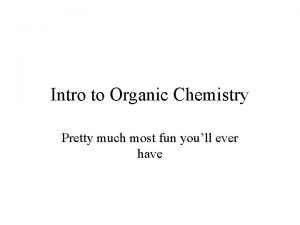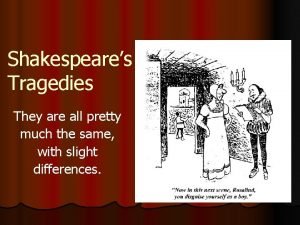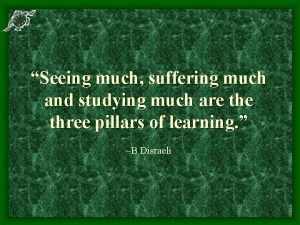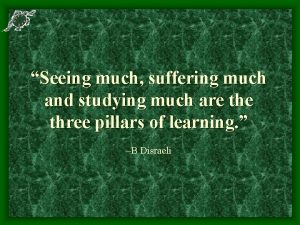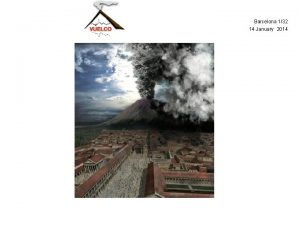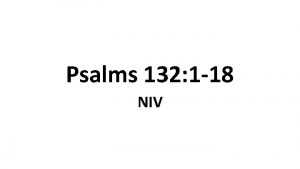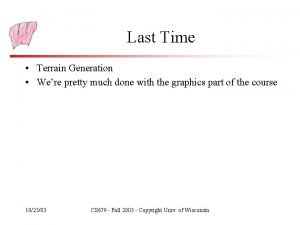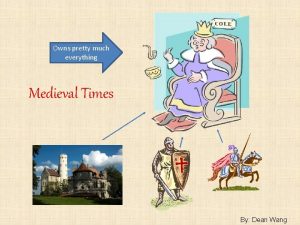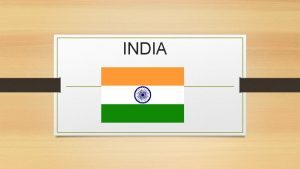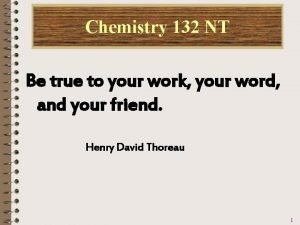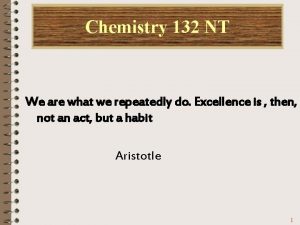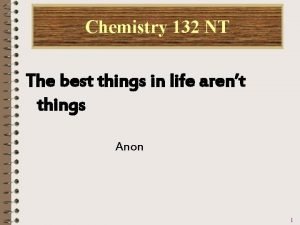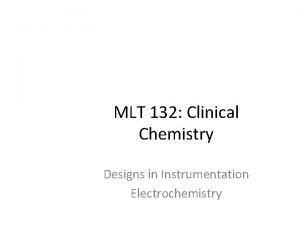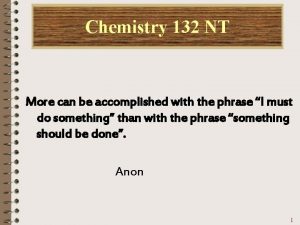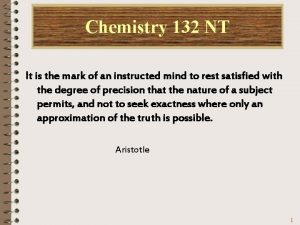Chemistry 132 NT Pretty much all the honest

































- Slides: 33

Chemistry 132 NT Pretty much all the honest truthtelling there is in the world is done by children. Oliver Wendell Holmes 1

Chemical Equilibrium Chapter 14 Module 3 Sections 14. 7, 14. 8, and 14. 9 Oscillating patterns formed by a reaction far from equilibrium 2

3

Review Qualitatively interpreting the equilibrium constant. Predicting the direction of reaction using Qc. Calculating equilibrium concentrations (also using the quadratic equation). 4

Le Chatelier’s Principle Obtaining the maximum amount of product from a reaction depends on the proper set of reaction conditions (see Figure 14. 8). Le Chatelier’s principle states that when a system in a chemical equilibrium is disturbed by a change of temperature, pressure, or a concentration, the equilibrium will shift in a way that tends to counteract this change. 5

Removing Products or Adding Reactants Let’s refer back to the illustration of the U-tube in the first section of this chapter. “reactants” “products” It’s a simple concept to see that if we were to remove products (analogous to dipping water out of the right side of the tube) the reaction would shift to the right until equilibrium was reestablished. 6

Removing Products or Adding Reactants Let’s refer back to the illustration of the U-tube in the first section of this chapter. “reactants” “products” Likewise, if more reactant is added (analogous to pouring more water in the left side of the tube) the reaction would again shift to the right until equilibrium is reestablished. 7

A Problem To Consider Predict the direction of reaction when H 2 is removed from a mixture (lowering its concentration) in which the following equilibrium has been established. When H 2 is removed from the reaction mixture, lowering its concentration, the reaction goes in the reverse direction to partially restore the H 2 that was removed. (see Exercise 14. 12 and Problem 14. 63) 8

Effects of Pressure Change A pressure change caused by changing the volume of the reaction vessel can affect the yield of products in a gaseous reaction only if the reaction involves a change in the total moles of gas present. The methanation reaction below is an example of a change in the moles of gas. 9

Effects of Pressure Change A pressure change caused by changing the volume of the reaction vessel can affect the yield of products in a gaseous reaction only if the reaction involves a change in the total moles of gas present. When the reaction goes in the forward direstion, four moles of reactant gas (CO + 3 H 2) become two moles of product gas (CH 4 + H 2 O). 10

Effects of Pressure Change If the products in a gaseous reaction contain fewer moles of gas than the reactants, it is logical that they would require less space. So, reducing the volume of the reaction vessel would favor the products in this case. 11

Figure 14. 9 (A) The original equilibrium mixture of CO, H 2, CH 4, and H 2 O. 12

Figure 14. 9 (A) (B) The gases are compressed to one-half the original volume, increasing their partial pressures…no longer at equilibrium. 13

Figure 14. 9 (A) (B) (C) Equilibrium is reestablished when the reaction goes in the forward direction. 14

Effects of Pressure Change So literally “squeezing” the reaction will cause a shift in the equilibrium toward the fewer moles of gas. It’s a simple step to see that reducing the pressure in the reaction vessel by increasing its volume would have the opposite effect. 15

Effects of Pressure Change So literally “squeezing” the reaction will cause a shift in the equilibrium toward the fewer moles of gas. In the event that the number of moles of gaseous product equals the moles of gaseous reactant, vessel volume will have no effect on the position of the equilibrium. For example, 2 moles of gas 16

A Problem To Consider Look at the following equations and decide whether an increase in pressure (by decreasing the volume) will increase, decrease, or have no effect on the amount of products. CO(g) + Cl 2(g) COCl 2(g) This reaction decreases the molecules of gas (from two to one). According to Le. Chatelier’s principle, an increase in pressure should increase the amount of product. 17

A Problem To Consider Look at the following equations and decide whether an increase in pressure (by decreasing the volume) will increase, decrease, or have no effect on the amount of products. 2 H 2 S(g) 2 H 2(g) + S 2(g) This reaction increases the molecules of gas (from two to one). According to Le. Chatelier’s principle, an increase in pressure should decrease the amount of product. 18

A Problem To Consider Look at the following equations and decide whether an increase in pressure (by decreasing the volume) will increase, decrease, or have no effect on the amount of products. C(s) + S 2(g) CS 2(g) This reaction does not change the number of molecules of gas. (note that we ignore solid carbon) According to Le. Chatelier’s principle, an increase in pressure has no effect. (see Exercise 14. 13 and Problem 14. 65) 19

Effect of Temperature Change Temperature has a significant effect on most reactions (see Figure 14. 10). Reaction rates generally increase with an increase in temperature, consequently, equilibrium is established sooner. In addition, the numerical value of the equilibrium constant Kc varies with temperature. 20

Effect of Temperature Change Let’s look at “heat” as if it were a product in exothermic reactions and a reactant in endothermic reactions. This ultimately has the same effect as if heat were a physical entity. We see that increasing the temperature is analogous to adding more product (in the case of exothermic reactions) or adding more reactant (in the case of endothermic reactions). 21

Effect of Temperature Change For example, consider the following generic exothermic reaction. “reactants” “products” Heat Increasing temperature would be analogous to adding more product causing the equilibrium to shift left. 22

Effect of Temperature Change For example, consider the following generic exothermic reaction. “reactants” “products” Heat Since “heat” does not appear in the equilibrium-constant expression, this would result in a smaller numerical value for K c. 23

Effect of Temperature Change For an endothermic reaction, the opposite is true. “reactants” Heat “products” Increasing temperature would be analogous to adding more reactant causing the equilibrium to shift right. 24

Effect of Temperature Change For an endothermic reaction, the opposite is true. “reactants” Heat “products” This results in more product at equilibrium resulting in a larger numerical value for K c. 25

Effect of Temperature Change So, in summary: For an endothermic reaction (DH positive) the amounts of products are increased at equilibrium by an increase in temperature (Kc is larger at higher temperatures). For an exothermic reaction (DH is negative) the amounts of reactants are increased at equilibrium by an increase in temperature (Kc is smaller at higher temperatures). 26

A Problem To Consider Carbon monoxide is formed when carbon dioxide reacts with solid carbon (graphite). CO 2(g) + C(graphite) 2 CO (g) ; DHo = 172. 5 k. J Is a high or low temperature more favorable to the formation of carbon monoxide? The reaction absorbs heat in the forward direction. That is: HEAT + CO 2(g) + C(graphite) 2 CO (g) 27

A Problem To Consider Carbon monoxide is formed when carbon dioxide reacts with solid carbon (graphite). CO 2(g) + C(graphite) 2 CO (g) ; DHo = 172. 5 k. J Is a high or low temperature more favorable to the formation of carbon monoxide? As the temperature is raised, reaction occurs in the forward direction. HEAT + CO 2(g) + C(graphite) 2 CO (g) 28

A Problem To Consider Carbon monoxide is formed when carbon dioxide reacts with solid carbon (graphite). CO 2(g) + C(graphite) 2 CO (g) ; DHo = 172. 5 k. J Is a high or low temperature more favorable to the formation of carbon monoxide? Thus, high temperature is more favorable to the formation of carbon monoxide. HEAT + CO 2(g) + C(graphite) 2 CO (g) (see Exercise 14. 14 and Problem 14. 67) 29

Effect of a catalyst A catalyst is a substance that increases the rate of a reaction but is not consumed by it. It is important to understand that a catalyst has no effect on the equilibrium composition of a reaction mixture (see Figure 14. 12). A catalyst merely speeds up the attainment of equilibrium. 30

Key Equations Chapter 14 Homework: To be collected at the first exam. Review Questions: 10 Problems: 63, 67, 79, 81, 87, 91, 95, 101, 105. 31

Operational Skills Solving equilibrium problems Applying Le Chatelier’s principle Time for a few review questions. 32

33
 All flowers are pretty objects
All flowers are pretty objects How much caffeine in a snickers bar
How much caffeine in a snickers bar To whom much is given much is expected meaning
To whom much is given much is expected meaning How much is too much plagiarism
How much is too much plagiarism Name all rays
Name all rays 123 132 213 231 312 321
123 132 213 231 312 321 Rule 132
Rule 132 29 cfr 1910 regarding face head foot and hand protection
29 cfr 1910 regarding face head foot and hand protection Gangs in oklahoma city
Gangs in oklahoma city Impower 132
Impower 132 20 decenas de mil
20 decenas de mil Impower 132
Impower 132 Square roots addition
Square roots addition What phenomenon is created by two tuning forks
What phenomenon is created by two tuning forks 131 ortaklardan alacaklar hesabı
131 ortaklardan alacaklar hesabı Algorithme division par soustractions successives
Algorithme division par soustractions successives 132 sonetas
132 sonetas Krakowska korv
Krakowska korv Hasil dari 108 + 132 dikurang 134
Hasil dari 108 + 132 dikurang 134 Cirkel area
Cirkel area Advanced dc motor
Advanced dc motor Sfas no 132
Sfas no 132 Ver conjugation
Ver conjugation Impower 132
Impower 132 Patrimonio de una persona
Patrimonio de una persona Transopia
Transopia Phy 132
Phy 132 Cse132
Cse132 132,000 ves
132,000 ves Articulo 132 lomce
Articulo 132 lomce Cse 132
Cse 132 Database system implementation pdf
Database system implementation pdf Http://132
Http://132 Honest appraisal
Honest appraisal
